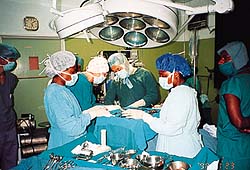Official Development Assistance (ODA)
The Papua New Guinea Tidal Wave Disaster: Dispatch of a Japan
On the evening of July 17, 1998, an earthquake measuring 7.0 on the Richter scale occurred off the coast of West Sepik State in northwestern Papua New Guinea, sending a tidal wave over 15 meters high rushing toward villages in the coastal districts of Aitape and Sissano. The wave swept over and washed away many beachfront homes, taking the lives of over 2,000 citizens in the process and creating hardship for 10,000 or more.
Moved by the tragedy, the Japanese government immediately notified Papua New Guinean authorities of its readiness to provide emergency aid. On request, Japan decided on July 21st to send an 11-member team of emergency medical personnel, and placed it on a flight out of Narita the same day. On the 22nd, the team arrived at Wewak General Hospital, where many of the seriously injured were being treated.
During their 10 days on duty, team personnel were involved in the care and surgical treatment of 104 of the injured, 26 of whom underwent operations at the hands of two of the team surgeons themselves. Team members also assisted the hospital in getting things back under control after the disaster by repairing medical instrumentation, filling out medical forms, and in other ways functioning as temporary hospital staffers.
This show of dedication and effort earned the team the appreciation and trust of the hospital, which was seriously short on manpower following the disaster. As a result, on the fourth day of its stay, the team was entrusted with two of the hospital's six wards.
Wewak Hospital already had strong ties with Japan. In FY 1990 and 1991, it upgraded its facilities and equipment with Japanese grant aid. On top of that, the hospital's chief executive officer, Dr. Linda, had visited Japan in the past as a JICA trainee. However, in one respect, the local operations of the Japanese rescue team also helped strengthen friendship ties at the grassroots level. As one hospital staffer put it: "My image of Japan was once that of an important country far, far away. However, having had the chance to work together with several Japanese, I now realize they are no different from us, and have the feeling Japan is not so far away after all." In particular, when the team members were preparing to return to Japan, the hospital's nurses gathered to see them off. The team's only woman member was a nurse herself. The sight of her hugging and bidding the local nurses a tearful farewell seemed to symbolize the value of Japan's international rescue team framework as an expression of Japanese ODA with human interaction.

Medical team surgeons performing an operation (medical team nurses are at far left and third from right)
